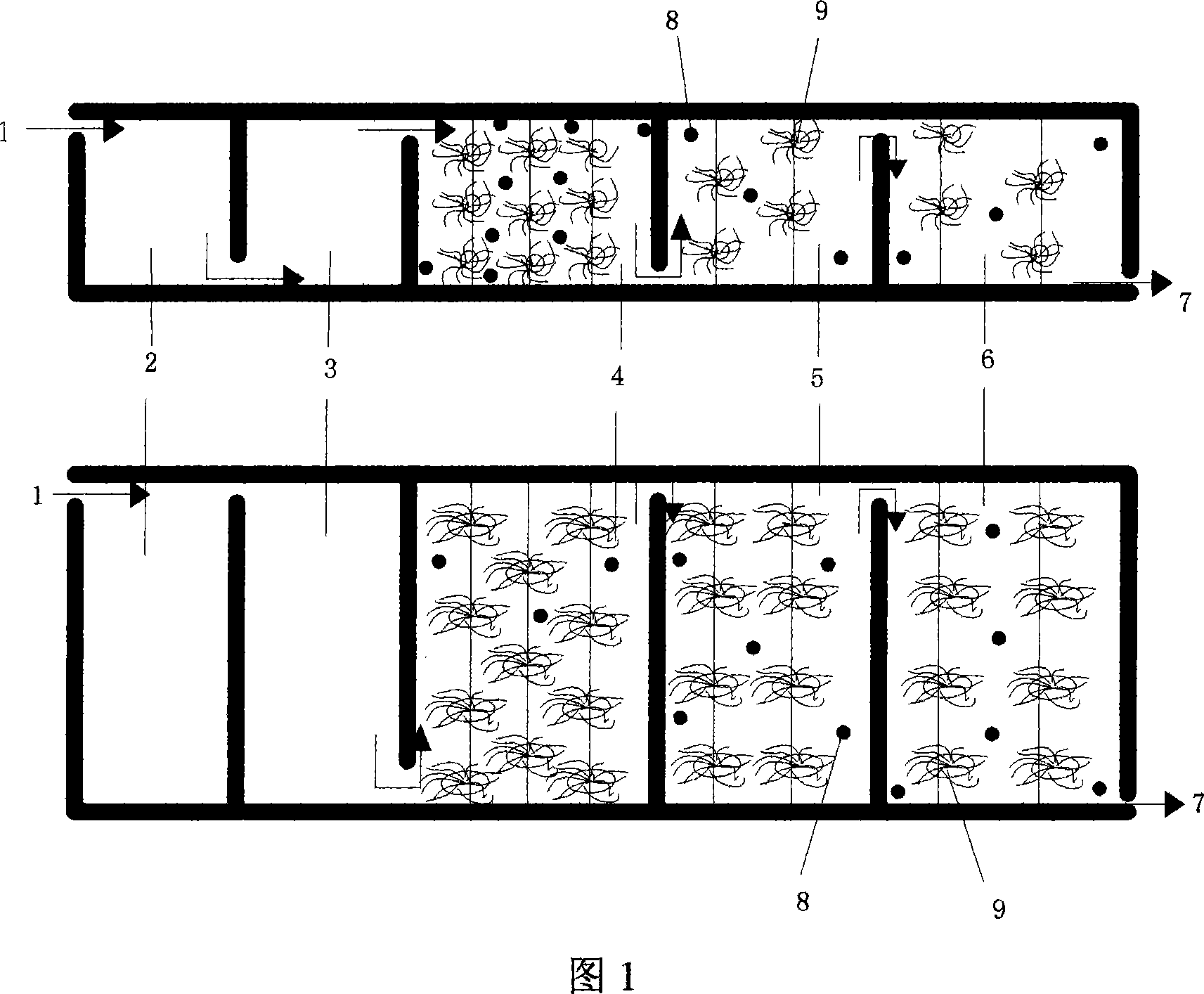Organism activated adsorption aeration sewage treating and water reusing method
A biological activation and sewage treatment technology, applied in the field of environmental protection, can solve the problems of failure to achieve the goal of domestic sewage reuse and high operating costs, and achieve the effects of reducing daily maintenance costs, optimizing design layout, and low prices
- Summary
- Abstract
- Description
- Claims
- Application Information
AI Technical Summary
Problems solved by technology
Method used
Image
Examples
Embodiment 1
[0031] (1) Anaerobic treatment with bioactivator
[0032] Three days before the start-up of the biologically activated adsorption aerated sewage treatment system, a bioactivator with a total concentration of 50 mg / L was added to the anaerobic tank 3 in the form of uniform spraying in water, once a day, and it was not necessary to add during normal operation. Daily input amount of bioactivator (M) According to empirical formula M=40-0.78×COD(g / m 3 )calculate. The bioactivator is composed of enzyme preparation, trace elements, amino acid and polysaccharide. Enzyme preparations account for 80% of the total, including 50% protease, 40% lipase and 10% cellulase. Trace elements account for 10% of the total, and trace elements are copper, zinc, manganese and cobalt. Amino acids and polysaccharides account for 10% of the total. The ratio of amino acids to polysaccharides is 1:2. Amino acids and polysaccharides are derived from food waste. The amino acids are glutamic acid and pheny...
Embodiment 2
[0041] (1) Anaerobic treatment with bioactivator
[0042] Three days before the start-up of the sewage treatment system with bioactivation adsorption aeration, the bioactivator with a total concentration of 60mg / L was added to the anaerobic pool 3 in the form of uniform spraying in water, once a day, and it was not necessary to add during normal operation. Daily input amount of bioactivator (M) According to empirical formula M=38-0.8×COD(g / m 3 )calculate. The bioactivator is composed of enzyme preparation, trace elements, amino acid and polysaccharide. Enzyme preparations account for 75% of the total, including 50% protease, 40% lipase, and 10% cellulase; trace elements account for 10% of the total, and trace elements are copper, zinc, manganese, cobalt and molybdenum; amino acids and polysaccharides Accounting for 15% of the total, the ratio of amino acid to polysaccharide is 2:3. Amino acid and polysaccharide come from food waste, amino acid is phenylalanine, and polysacch...
Embodiment 3
[0051] (1) Anaerobic treatment with bioactivator
[0052] Five days before the bioactivation adsorption aeration sewage treatment system is started, the bioactivator with a total concentration of 80mg / L is added to the anaerobic tank 3 by uniform spraying in water, once a day, and it is not necessary to add during normal operation. Daily input amount of bioactivator (M) according to empirical formula M=45-1.8×COD(g / m 3 )calculate. The bioactivator is composed of enzyme preparation, trace elements, amino acid and polysaccharide. Enzyme preparations account for 80% of the total, of which protease 40%, lipase 40%, cellulase 20%; trace elements account for 10% of the total, trace elements include copper, zinc, manganese; amino acids and polysaccharides account for the total 10%, the ratio of amino acid to polysaccharide is 3:4, amino acid and polysaccharide come from food waste, amino acid is glutamic acid, polysaccharide is lactose. The above-mentioned contents are all percent...
PUM
| Property | Measurement | Unit |
|---|---|---|
| dissolved oxygen | aaaaa | aaaaa |
| clearance rate | aaaaa | aaaaa |
| clearance rate | aaaaa | aaaaa |
Abstract
Description
Claims
Application Information
 Login to View More
Login to View More - R&D
- Intellectual Property
- Life Sciences
- Materials
- Tech Scout
- Unparalleled Data Quality
- Higher Quality Content
- 60% Fewer Hallucinations
Browse by: Latest US Patents, China's latest patents, Technical Efficacy Thesaurus, Application Domain, Technology Topic, Popular Technical Reports.
© 2025 PatSnap. All rights reserved.Legal|Privacy policy|Modern Slavery Act Transparency Statement|Sitemap|About US| Contact US: help@patsnap.com

